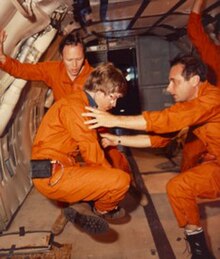| Space adaptation syndrome | |
|---|---|
 | |
| NASA astronauts acclimating themselves to space adaptation syndrome in a KC-135 airplane that flies parabolic arcs to create short periods of weightlessness.[1] In about two thirds of the passengers, these flights produce nausea,[2][3] giving the plane its nickname "vomit comet". | |
| Specialty | Space medicine |
| Prevalence | 50% of individuals |
Space adaptation syndrome (SAS) or space sickness is a condition experienced by as many as half of all space travelers during their adaptation to weightlessness once in orbit.[4] It is the opposite of terrestrial motion sickness since it occurs when the environment and the person appear visually to be in motion relative to one another even though there is no corresponding sensation of bodily movement originating from the vestibular system.[5]
- ^ "Mixed Up in Space". NASA. 2001-08-07. Archived from the original on 2009-05-13. Retrieved 2009-05-28.
- ^ Golightly, Glen (October 20, 1999). "Flying The Vomit Comet Has Its Ups And Downs". space.com. Archived from the original on 2006-03-10.
- ^ "Reduced Gravity: Vomit Comet Blog". PhysicsCentral. May 10, 2005. Retrieved 2007-11-07.
- ^ Quine, Tony (April 2007). "Addicted to space: An appreciation of Anousheh Ansari, Part II". Spaceflight. 49 (4): 144. ISSN 0038-6340.
- ^ "Why Do Astronauts Suffer From Space Sickness?". ScienceDaily. 2008-05-23.